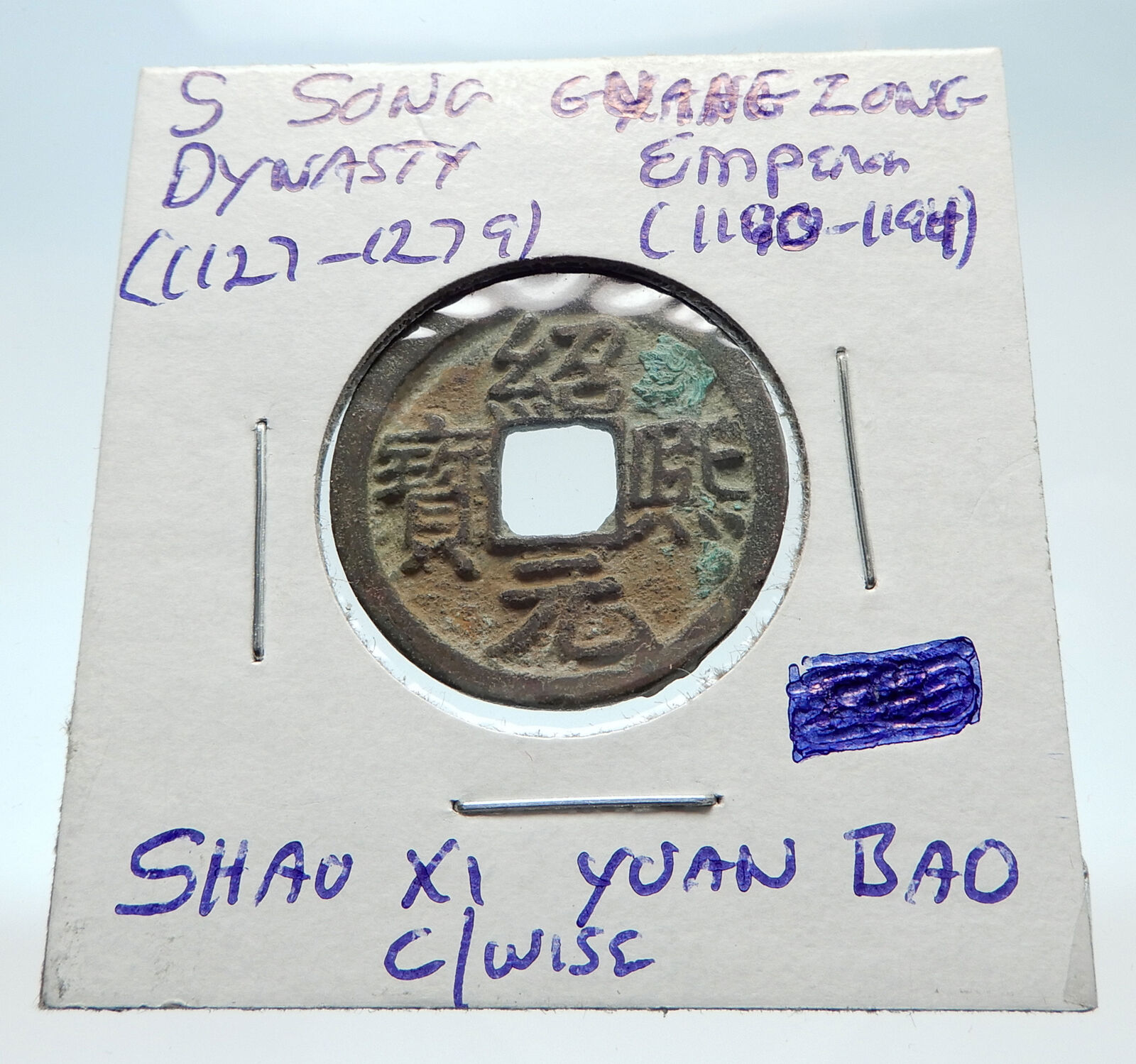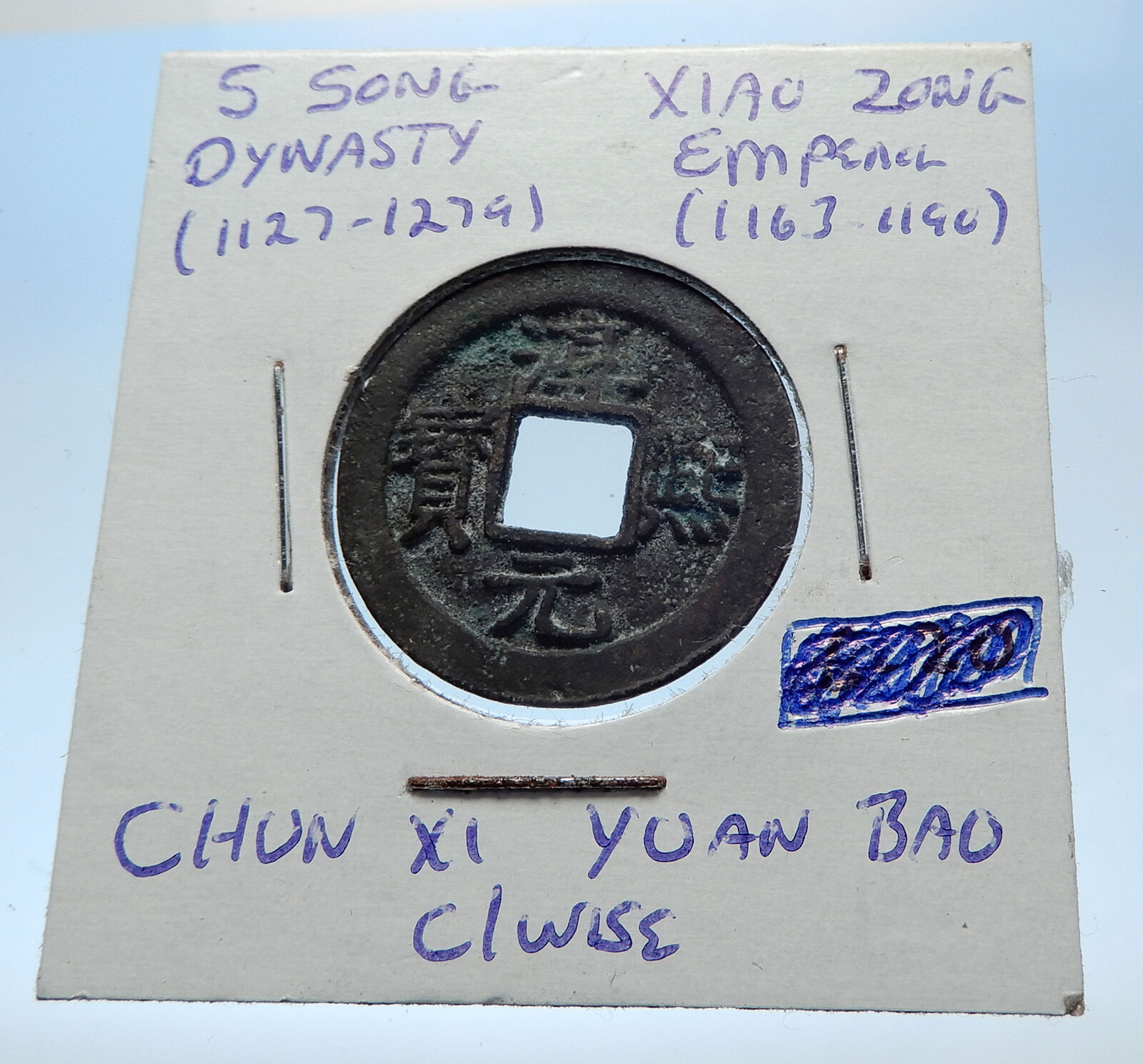|
China – Ban Liang. Western Han Dynasty Types
Bronze 4 Zhu ‘Cash Coin’ 24mm (2.59 grams)
Cast circa 175-119 B.C.
Reference: Hartill 7.16
You are bidding on the exact item pictured, provided with a Certificate of Authenticity and Lifetime Guarantee of Authenticity.
The Ban Liang (Traditional Chinese: 半兩 ; Pinyin: bàn liǎng) was the first unified currency of the Chinese empire, first minted as early as 378 BCE and introduced by the first emperor Qin Shi Huang as China’s first unified currency around 210 BC (although coins with this inscription already circulated in the State of Qin prior to unification). It was round with a square hole in the middle. Before that date, a variety of coins were used in China, usually in the form of blades (knife money, spade money) or other implements, though round coins with square holes were used by the State of Zhou before it was extinguished by Qin in 249 BCE.
The Ban Liang corresponds to a “half tael” (半兩), or twelve zhu (銖, about 0.68 grams). It typically weighs between ten and six grams, roughly corresponding to the Greek stater.
The standardization of currency with this round coinage was part of a broader plan to unify weights and measures during the Qin empire. Ban Liang coins continued to be used under the Western Han dynasty until they were finally replaced by the Wu Zhu cash coins in 118 BC.
State of Qin
The Ban Liang coins predate the Chinese Empire and were originally cast during the Warring states period by the State of Qin; these coins circulated alongside cloth money.[5][6][7] Qin State coins were inscribed with the Chinese characters “Zhu zhong yi liang” (珠重一兩, “pearls (round coins) heavy one liang”), which might have been kind of lot numbers, while other early State of Qin weighed half a tael or one zi {中冖田} (甾, 錙), which was six zhu. 1 tael coins tended to have a round centre hole, and half tael coins a square hole. The reverse side of all of these early round coins were blank.
The Ban Liang cash coins of the Warring States period typically have a diameter between 32 and 34 millimeters and weight of 8 grams.[7] The Ban Liang cash coins produced by the State of Qin have rectangular centre holes, as opposed to later cash coins which have square holes and many earlier Huanqian which had round holes.
Ban Liang cash coins during this era were cast in two-piece moulds (traditional Chinese: 錢范; simplified Chinese: 钱范; pinyin: qián fàn) and these moulds could produce 6 cash coins at a time.[7] This casting method left only one sprue on the coins.
State of Qin era Ban Liang cash coins generally have inscriptions that are written in small seal script, with a small number in large seal script. The characters on the State of Qin Ban Liang cash coins are vertically elongated and the top horizontal stroke of the “Liang” (兩) character is short. A seal script evolved further over the centuries, the top horizontal line became longer as is seen in Ban Liang cash coins produced during the time of the Han dynasty.
Qin dynasty
Emperor Qin Shi Huang conquered the various “warring states” and unified China in the year 221 BC forming the Qin dynasty. In order to consolidate central power of the new Qin dynasty, Qin Shi Huang proceeded to standardise the various scripts, weights, and measures that existed among the various states. In order to centralise and standardise the Chinese monetary system, Qin Shi Huang had abolished the existing forms of money. He then stipulated that the new monetary system of the Qin dynasty would consist of a two tier system with a “higher” form of currency (上幣) made of gold and a “lower” form of currency (下幣) made of bronze, which was the Ban Liang.
The Qin dynasty’s Ban Liang cash coin was introduced as a way to standardise all forms of currency and its name reflected this as it would always weigh half a tael; these coins were mostly made from bronze, though a silver Ban Liang variant is known to exist. According to the standard “weights and measures” (度量衡) of Qin, one tael was 24 zhu (equivalent to about 14.4 grams). A “Ban Liang” cash coin, which means “half liang” or “half tael”, would therefore be about 7.2 grams in weight. The Ban Liang cash coins further introduced the tradition of stringing coins together with a rope for convenience; this was because of its round shape with a square hole, something future Chinese coins would continue to do until the early days of the Republic of China in the 1910s AD.
The inscription written on Qin dynasty era Ban Liang cash coins are all written in seal script with long and narrow characters that were written in a primal freehand style. Early Ban Liang cash coins tended to not be well finished, furthermore these coins tended to not be quite round as their rims were often not filed smooth.[9]
Han dynasty
Main article: Han dynasty coinage
During the Han dynasty Ban Liang coins continued to be produced, but the golden currency established under the Qin would switch from being measured in taels to being measured in “Jin” (斤), which made a single Jin-denominated gold coin worth around 10.000 Ban Liang coins. As the general populace found inconvenience in using the heavy Ban Liang coins the Han government allowed for the private production of smaller Ban Liang coins known as “elm seed” (榆莢) Ban Liang coins. The design of the Ban Liang coins would also change as Han dynasty Ban Liangs would later add rims while all Qin dynasty versions were rimless.
In the year 186 BC, or the 5th year of Empress Lü, the government officially set the weight of the Ban Liang at 8 zhu and the inscription was now written in clerical script.[9]
In the year 182 BC, or the sixth year of Empress Lü, the government of the Han dynasty began cast Ban Liang cash coins with a weight of 2.4 zhu. These cash coins had a diameter that was only about 20 millimeters, and they were distinguished by a large square centre hole. Because in reality they were only worth one-fifth of an earlier Ban Liang coin, they are usually referred to as “5 parts Ban Liang cash coins” (五分半兩錢).
In the year 175 BC, or the fifth year of Emperor Wen, the government of the Han dynasty set the weight of the Ban Liang cash coins at 4 zhu. These cash coins typically have a diameter between 23 and 25 millimeters and they tend to have a weight of 3 grams or less. Some 4 zhu Ban Liang cash coins have an outer rim, while a far fewer number of this type of Ban Liang have both an outside rim as well as an inside rim located around the square centre hole.
Eventually the private production of coinage led to a major disruption in the economy forcing the government to produce larger Ban Liang; eventually, the Han government continue to change the size and weight of the Ban Liang weighing as light as 2.4 Zhu to 4 Zhu. In 119 BC Emperor Wu ordered the Ban Liang coins to be deprecated in favour of “San Zhu” cash coins (三銖), which in turn were superseded by the “Wu Zhu” (五銖) series of coins in 118 BC. Despite being superseded by cash coinages with other inscriptions, the Ban Liang would continue to circulate in the Han dynasty.
Variants
During their period of production many types of Ban Liang coins were cast, ranging largely in weight and size, some had extra holes, while other were written in different fonts such as the Han dynasty coins cast under Empress Lü written in Regular script, or a rare Ban Liang made from silver in the Qin dynasty,[7] an iron variant, and a lead variant in the Han dynasty. A variant with a reverse inscription known as “Liang Ban” (兩半) coins were also cast, cash coins with reverse inscriptions are known as chuan xing (傳形).
During the Warring states period Ban Liang coins from the State of Qin generally had 8 gram Ban Liang coins from between 32 and 34 millimeters in diameter, while during the Qin dynasty all Ban Liang coins generally had a weight of 6 grams and were about 31.7 millimeters in diameters. Han dynasty era Ban Liang coins are generally smaller than Qin Ban Liang coins, this is due to the Han dynasty government constantly changing weight standards for the coins many variants from that era exist.
|










